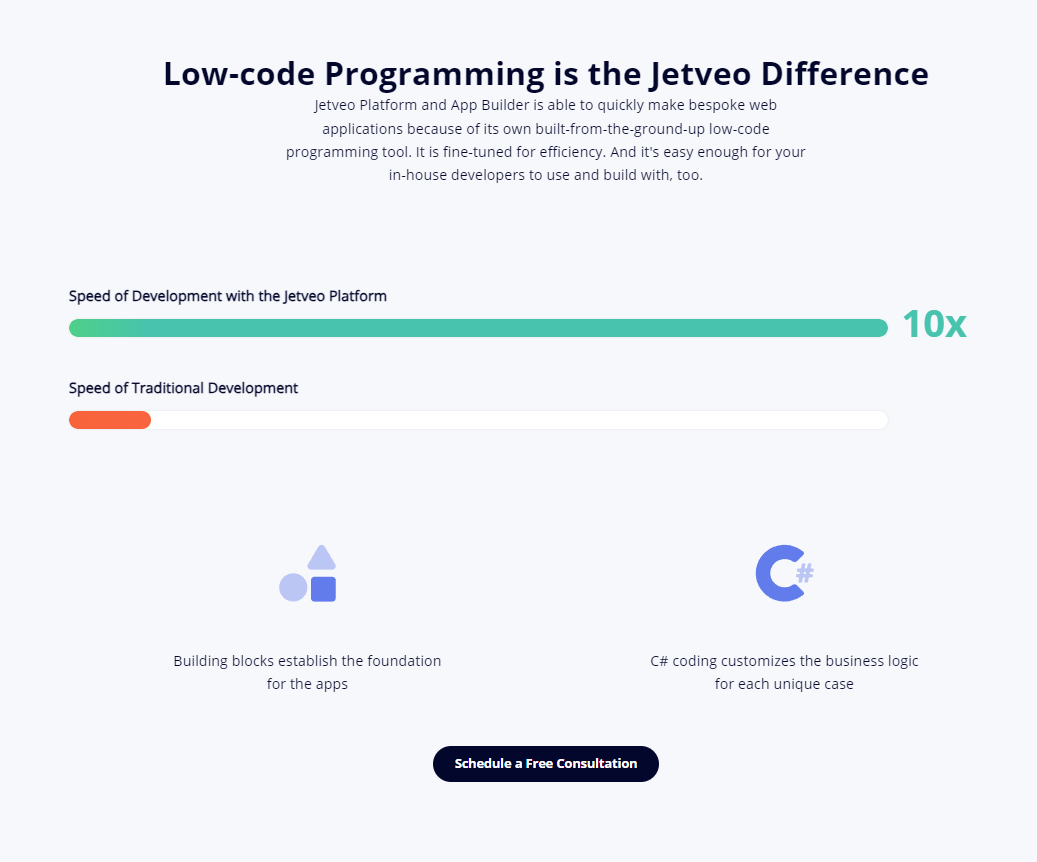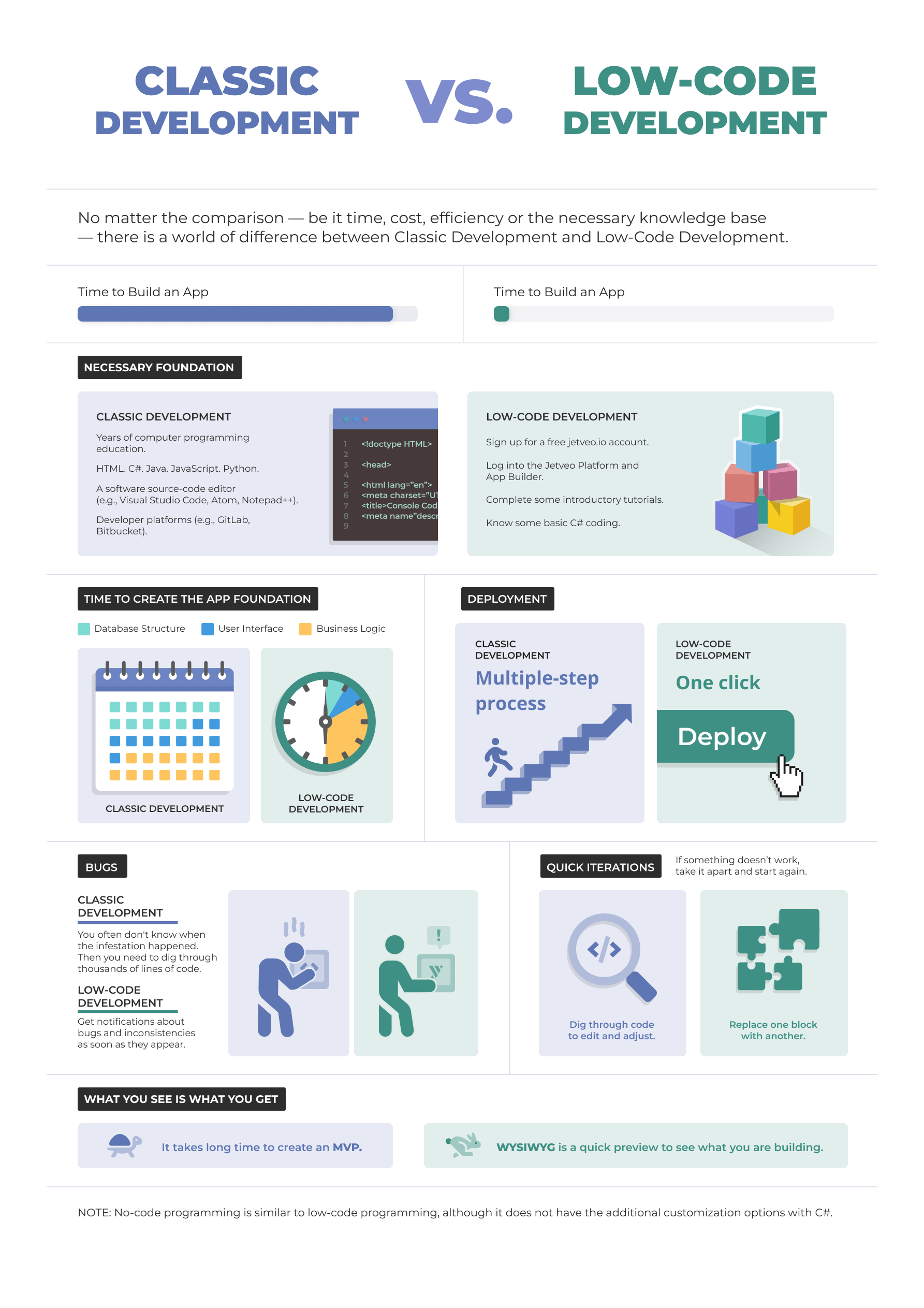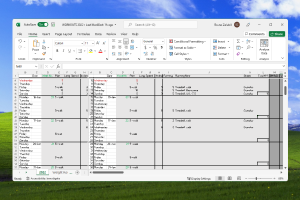23 Ways Low-code Programming is Better than Classic Programming
What happens when you pit Low-code Programming against Classic Programming? Spoiler Alert: Low-code wins!
Low-code programming platforms offer many advantages. With just a little bit of understanding, users take existing building blocks, assemble them, and release a workable app in a matter of minutes. Then, customization is done with C# coding.
Larger projects take days or weeks, but definitely not months and years.
But speed is only the start of the power of low-code programming. There are many more benefits that low-code programming provides to companies who want a technological boost.
Here are 23 reasons the Jetveo low-code programming platform has replaced classic programming (and stayed ahead of no-code programming) for more efficient, more affordable, and, most definitely faster, app development.
Scroll down to see the “Classic Development X Low-code Development” Infographic.
SPEED
1. Fast Development
Low-code programming was developed as a fast and efficient response to resource-heavy classic programming. It uses established procedures and builds upon existing foundations so that programmers need not write the same foundational code for each app. In other words, there is no need to reinvent the wheel for each new project. This is quite different from classic development, which often requires thousands of lines of code written by teams of well-educated programmers. No-code programming is fast; but it is limiting because it lacks customization and it is impractical for large and complex apps.
2. Include the Customer Early
Quick iterations (and preview versions) are useful for programmers as they build the software because they can double-check their work as they go. It also allows for the quick development of a Minimum Viable Product so that the customer can quickly get involved to provide feedback and adjustments for customization.
EASE OF USE
3. Intuitive Layout
Low-code platforms generally have a step-by-step design with graphical features. - Layouts are consistent across all of the sections. - Logical connections are part of the building process, so that linking codebook static lists to specific attributes are simple push-button operations. - Many elements are similar to those found in more established software platforms, like Virtual Studio, and most interfaces are familiar to experienced programmers, including the common keystrokes.
4. Short Learning Curve
Simplicity is a major low-code selling point. Step-by-step guides, instructional boot camps, videos, and tutorials get new users up to speed so that they can quickly begin developing their own apps.

5. Support and Online Help
Most low-code platforms, including Jetveo, offer guidance and help, including introductory boot camps, tutorials for implementing templates and features, and tool-tip hints on every step of the app builder. Detailed documentation is available on Developer Portals and Help Pages.
6. Cheat Sheet
Imagine that you didn't have to sit through semesters of competitive programming classes, take stressful tests, and pay exorbitant amounts of money in tuition. In other words, imagine that you were given a cheat sheet with simple explanations for everything that you will need. That is what you get with low-code programming: building blocks instead of thousands of lines of code.
CUSTOMIZATION
7. C# Coding
Low-code provides access to the source code in order to add customization to define custom business logic throughout the software. C# coding does require knowledge. But much can be done with only a basic understanding of the programming language.
8. Business Logic
Low-code enables the programmer to fine tune features, like workflows, to the exacting business logic required for each individual client.

POWERFUL FEATURES
9. Cloud Storage
Low-code platforms are offered through a Platform-as-a-Service model. This enables the programmer to access the platform wherever the internet is available, and not tie the user to a single computer (although on-premises storage is also available). Data and source code is maintained safely and securely in the cloud, like in the Azure cloud. Updates are made smoothly and efficiently.
10. Third-party Connections
All of the necessary tools are available for building, testing, and running apps. NuGet packages, from a library of thousands, can be implemented. Front-end user interfaces, like Gatsby, are available.
11. Time-saving Tools
Shortcut keystrokes provide quick access to common pages. Magic-wand wizards streamline repetitive tasks to implement established business logic. Codebook static lists can be populated by cutting and pasting from a spreadsheet. Reference lists are created through an easy grid layout. Automation is available so that, rather than more typing (and potential error), several naming processes automatically generate additional formats, like the plural forms of the entity names, the automatic creation of UI pages, and the population of drop-down menus. Cheat sheets and templates accelerate the creation process.
12. Finding Bugs
The better low-code platforms have processes to provide warnings about bugs and inconsistencies as soon as they appear, potentially saving hours of agony digging through thousands of line of code.
13. Building Blocks
Most low-code platforms include versions of the following: Templates and components that can be plugged into the app; deployment to the internet that takes one click; and quick iterations that enable the user to keep an eye on the process, come up with new ideas, and, in consultation with customers, make additional customizations.
14. WYSIWYG
Conducting a full release of source code can be long and laborious, especially when you simply want to know how the final product will look. A what-you-see-is-what-you-get preview shows the real-time version of the software as it is being built.
TEAM CONCEPT
15. Work Together
Most apps can be built by one junior developer. Large and complex projects can be broken up into small pieces so that multiple developers can work at the same time and provide their personal expertise, like database creation, back end development, and front end development, before all of the parts are merged together into one.
16. Benefits of Teamwork
This team concept has many knock-on effects: - Senior programmers can use their experience and expertise; - Junior programmers can be brought into larger projects through the periphery, learning on the job; - Teams include different points of view and more collective creativity; and - Replacing team members and juggling resources is more efficient. In general, the intuitive interface enables developers to start working immediately, getting their hands dirty and providing a real-world learning experience.

17. No Need for a Huge Development Team
Classic programming often requires specialists for database architecture, user interface design, integration, security, source-code release, publication, quality assurance, testing, and support. All of this can be handled through a low-code platform.
18. Empower Junior Programmers
The simplicity of the low-code system allows for junior programmers to quickly learn the system, then carry a significant amount of work load, allowing your teams to work on more projects and save a bit on salary.
POTENTIAL
19. Many Types of Apps Can Be Created
Apps can handle a wide range of features, including (but not limited to): digitalization and the ability to work with data; the development of smart forms; simple procedures for approvals; the establishment of logical workflows; well-defined document management; the development of a mobile back end as the foundation for a mobile front end user interface; integrations with any number of other apps; a modern feel for normal operations; and much more. CRM. WMS. ERP. The sky is the limit.
20. Citizen Programmers
You don't need years of education to use a low-code platform. Nor do you need even a tiny bit of experience with programming. If you can set up a Facebook page, you can build a simple app on a low-code platform. In fact, the simplicity of low-code and no-code platforms and their useability by non-programmers have added a new term to the tech lexicon: “citizen programmers”
21. Hand-over to Customers
The transparency of low-code platforms allows for the efficient transfer of finished apps to the customer to take over control and up-keep, should they request it.
COST
22. Savings
All of this contributes to the strongest argument of all: low-code programming is less expensive than classic programming. Faster development means less billable hours, fewer programmers means less salary, quick turnaround means that new apps can be implemented quickly.
BEST OF TWO PROGRAMMING MODELS
23. The Sweet Spot
Low-code programming takes the best parts of both classic programming (i.e., power and customization) and the best parts of no-code programming (i.e., speed and ease of use) and provides programmers with a faster, more customizable, and more affordable development platform.
The Tale of the Tape:
Check out how low-code programming has many advantages over classic programming.

 EN
EN
